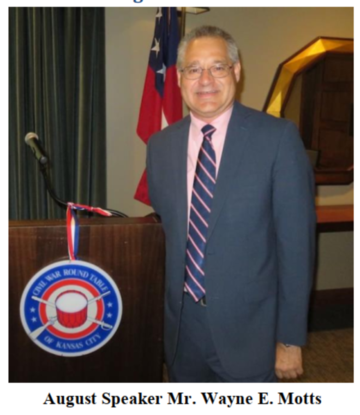August 2023 Meeting Summary

At the dinner meeting on August 16th, Mr. Wayne E. Motts, President and CEO of the Gettysburg Foundation gave a very interesting program titled: “The George Spangler Farm: 11th Army Corps Field Hospital at Gettysburg.”
Seized by Union forces of the 11th Army Corps on July 1, 1863, the previously tranquil farm of George Spangler was turned into an immense field hospital. From the first day of the Battle of Gettysburg, and for five weeks afterwards, the Spangler Farm hosted some 1,900 wounded soldiers of both sides. Among the patients treated there were Brigadier General Lewis Armistead of the Confederate Army mortally wounded in Pickett’s Charge, Union Brigadier General Francis Barlow, and Private George Nixon, the great grandfather of President Richard M. Nixon. This farm is the best preserved and interpreted hospital site not only from the Battle of Gettysburg, but also the American Civil War. Historian, guide, and author Wayne E. Motts presented the fascinating history of this significant property that was purchased by the Gettysburg Foundation in 2008 and subsequently preserved.
The following text is from the Gettysburg Foundation website: gettysburgfoundation.org
“Meticulously renovated, the site features restored, original buildings from the 1863 battle to inspire and explore:
- The stone farmhouse where George Spangler, his wife Elizabeth and four children lived. The family chose to remain during the battle and ongoing field hospital activities, with all six family members moved to just one room of their house.
- The Pennsylvania bank barn served as the hospital where both Union and Confederate soldiers received care.
- The summer kitchen used by the family during the warm Pennsylvania summers. Records indicate this is the place where Confederate General Lewis A. Armistead died from wounds he received during Pickett’s Charge.
“The historic site, with living history, docents and programming in summer, is open for visitors Friday through Sunday, early June through mid-August. Access and admission to the site is via timed shuttles departing the Gettysburg National Military Park Museum & Visitor Center.”
The following are some of the key points made by Mr. Motts during his presentation:
- The George Spangler Farm and Field Hospital is located 2.3 miles south of Gettysburg PA, between the Taneytown Road and the Baltimore Pike. It is the most preserved farmstead in the United States.
- The farm is situated near Rock Creek, which was a good water supply. Union surgeons were looking for a place south of Gettysburg, between the Union and Confederate lines. The farm was only one-half mile away from Pickett’s charge. During the battle the farm received overshot shells from Confederate artillery.
- Approximately 1,800 Union and 100 Confederate wounded soldiers were treated at the farm during and after the battle. There were 100 Union graves and 20 Confederate graves located on the farm. Dr. John W. C. O’Neal recorded the men who died and were buried on the farm. He also wrote down the burial
- locations. Some of the Union dead were reintered in the National Cemtery.
- The farm was owned by George Spangler, who was born in 1815 and died in 1904. He and his wife were married in 1841 and they had two boys and two girls. They purchased the farm in 1848. The family did not flee during the battle. They all stayed in one room of the farm house. The Spangler family owned the farm from 1848 to 1910, when one of the daughters sold it. The Spangler Farm was an active farm until 2008.
- The Gettysburg Foundation bought the Spangler Farm in 2008 for $1.8 million. They put $3.0 million into preserving four original structures and removing structures that were not there at the time of the battle. The four structures that were preserved are the house, summer kitchen, smokehouse, and barn. The farm originally had 166 acres. Today the farm has 80 acres.
- During the Battle of Gettysburg, the Baltimore Pike was a major avenue for the Union army. The Spangler Farm was used as a field hospital beginning on July 1, 1863. Dr. Daniel Brinton took over the farm for the Union. The Spangler farm field hospital was used to treat wounded soldiers for a total of five weeks and two days. By July 4th, there were 1,000 wounded soldiers at the farm.
- There were very few doctors available to treat the wounded. They mostly performed amputations. Dr. Brinton had to work 22 hours straight. Amputations were typically done outside, so that the doctors could see. Shells fell within 20 feet of the barn.
- Union Brigadier General Francis C. Barlow was wounded on July 1st and treated at the Spangler Farm. He died in 1896. Confederate Brigadier General Lewis A. Armistead was wounded during Pickett’s Charge on July 3rd and died at the Spangler Farm on July 5th.
- The Spangler’s farm buildings were damaged and their crops were destroyed during the battle. The Spanglers filed a claim with the U.S. government for $3,044. However, they were only awarded $60 for the loss of hay used during the battle.
- Mr. Motts presented a lot of information from various soldiers and nurses who worked at the Spangler Farm during and after the battle.
- Most of the army surgeons left after July 4th. There were a total of 21,000 wounded soldiers (16,000 Union and 5,000 Confederate) scattered around the Gettysburg area following the battle. The wounded Confederate soldiers had to be left behind when Lee’s army retreated back to Virginia and could not be transferred. Lee’s wagon train was 17 miles long!
- There were 2,500 wounded soldiers living in Gettysburg following the battle. The last wounded soldier left Camp Letterman on November 19th, the same day as Lincoln’s Gettysburg Address.
Mr. Motts said the Gettysburg Foundation has 25,000 members and supporters. Attendance at the August dinner meeting was 76, which included eleven members of the Gettysburg Foundation.